 |
 | ||||||||||||
|
|||||||||||||
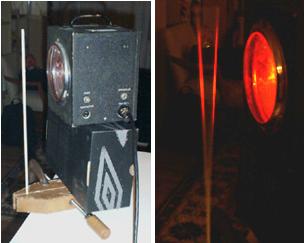
When you breathe in Helium, why does your voice sound funny?
This question came in when we did the the one with the Helium balloon in the schoolbus. At that time, we had shown that the 'schoolbus effect' had to do with the fact that air weighs more than Helium. The two most important things that determine the pitch of your voice are (1) your vocal cords and (2) your vocal tract which acts as a resonator, much like an organ pipe. This Helium effect is related to the second of these two. First we talked a bit about vibrations in general. I wanted to point out that in order to get vibrations in any medium, you need a spring, or something like it, which pushes a mass back and forth. The frequency of the vibration depends on the spring and the mass. This can be just about anything. I had brought in a thin fiberglass rod (left over from a kite building project), which I clamped to the table (see picture). You can measure the vibration speed by shining a strobe on it, and adjusting the strobe speed so that the rod appears to be (almost) standing still. The one shown swung about 11 times/second. Now if you clip a clothespin to the end, you can see that it vibrates slower, in this case about 7/second. The springiness of the rod is the same, but the mass is larger, therfore the frequency goes down. more mass > lower frequency or less mass > higher frequency You can also show this with a guitar (or similar instrument) by putting some tape on a string: the tone will go down. Take the tape off and the note will go back up.
OK, now to the Helium. I had a piece of 1" tube, 17" long. When you tap one end with your hand
the air inside resonates, and you
can hear a G (below middle C). If you fill the tube with Helium, the tone rises to D#, about half an octave higher.
Links:
|
|||||||||||||
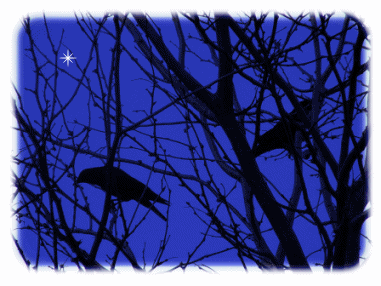
Why do stars twinkle?
This has to do with disturbances in the atmosphere that jiggle lightbeams as they pass through the air. You can show this effect with a laser pointer and a propane torch. Holding the flame in the path of the laser beam makes the spot jiggle noticably. The same happens when starlight passes through the atmosphere. There is a great movie of this on the link below of the Center for Adaptive Optics. The atmospheric disturbances jiggle the light, and blur the pictures. There are two solutions to this problem: One is to above the atmosphere, like the Hubble Space Telescope. The other solution is to use Adaptive Optics (AO). This is well explained at the site linked below. With adaptive optics you can 'unjiggle' the incoming light, and make incredibly sharp pictures, equal to or better than Hubble can do. For AO to work, you need a bright guide star in the field of view, so that the AO equipment can collect enough light quickly enough to to its job. If no such star is available, you can shoot a laser beam up to make an artificual guide star. This makes for a few great photos, some of which are linked below. Stars twinkle, but the moon and the planets do not, because they are disks (ok, when you look with a telescope or with binoculars), not point sources. This means that they are in a sense a large collection of point sources, all with their own independent jiggling and distortions. The image is still made fuzzy by this, but all the independent twinkling washes out, and as a result planets look like non-twinkling stars.
Links:
|
|||||||||||||
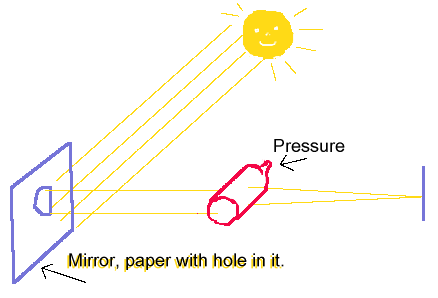
Making a lens out of air?
I've not actualy done this yet, but these are notes for when I get the chance. Can you make a lens out of air? Suppose I have a soda bottle, and I pressurize it with my bicycle pump (like this), would that be sufficient to focus a beam of sunlight (made with a mirror covered with paper with a 1" hole)?
The index of refraction of air at STP is
1 / n1 \ / 1 1 \ --- = | -- - 1.0 | * | -- - -- | f \ n2 / \ r1 r2 /so f is about 80 m for P=1 atm. If I pump to 60 psi, this reduces to 20m, and with 3 bottles, one behind the other, this reduces to about 7m, something you can actually do in the backyard (or the classroom).
Links:
|
|||||||||||||
| |||||||||||||

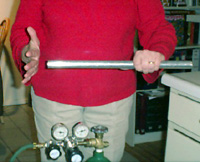
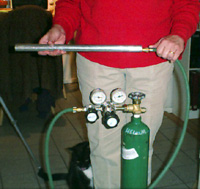
 So I made this holder that held 4 soda bottles, each with a cap with a screw-in tire valve. Some
1/4" hose and plactic tees and an elbow let me pressurize the whole thing to 80psi or so with the bicycle
pump or with my
So I made this holder that held 4 soda bottles, each with a cap with a screw-in tire valve. Some
1/4" hose and plactic tees and an elbow let me pressurize the whole thing to 80psi or so with the bicycle
pump or with my